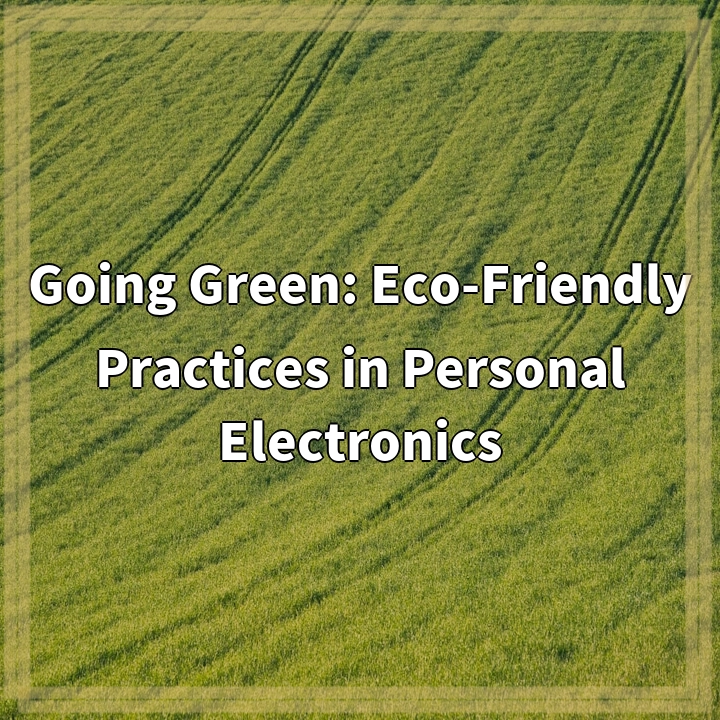
What it is:
Going Green: Eco-Friendly Practices in Personal Electronics is an emerging trend that focuses on promoting sustainability in the use and disposal of electronic devices. With the rapid advancement of technology and the increasing demand for electronic gadgets, there is a pressing need to address the environmental impact caused throughout the life cycle of these devices.
Real-World Problems:
The widespread and growing use of personal electronics has resulted in significant environmental challenges. Here are some of the real-world problems associated with personal electronics and the urgent need for adopting eco-friendly practices:
1. Electronic Waste:
Personal electronics generate a vast amount of electronic waste, also known as e-waste. This includes obsolete or broken devices that are improperly disposed of, usually ending up in landfills or incinerators. E-waste contains hazardous materials such as lead, mercury, and cadmium, which can leach into the soil and water, causing harm to ecosystems and human health.
2. Resource Depletion:
The production of personal electronics involves extracting scarce natural resources, including metals like gold, silver, and coltan. These resources are often obtained through destructive mining practices that contribute to deforestation, habitat destruction, and water pollution. By adopting eco-friendly practices, we can minimize resource extraction and reduce the environmental impact associated with raw material acquisition.
3. Energy Consumption:
Personal electronics consume a significant amount of energy throughout their life cycle. From manufacturing to daily usage and charging, these devices contribute to greenhouse gas emissions and contribute to climate change. Implementing energy-efficient practices, such as using low-power modes, optimizing power settings, and choosing energy-efficient devices, can significantly reduce energy consumption and environmental impact.
4. Planned Obsolescence:
Many personal electronics are designed with planned obsolescence in mind, meaning they are intentionally made to be short-lived or difficult to repair and upgrade. This results in a cycle of constant upgrading and discarding, contributing to the e-waste problem. By promoting repairability, longevity, and modularity in electronic devices, we can reduce waste and extend the lifespan of our gadgets.
By understanding these real-world problems associated with personal electronics, we can take steps towards adopting eco-friendly practices. In the next sections of this blog series, we will explore various solutions, case studies, and examples of successful eco-friendly practices in the personal electronics industry.

Solutions for Eco-Friendly Practices in Personal Electronics:
Implementing eco-friendly practices in the personal electronics industry is crucial to mitigate environmental impact and promote sustainability. Here are some solutions that can contribute to a greener future:
1. Responsible E-Waste Management:
Proper disposal and recycling of electronic devices are essential to minimize the negative effects of e-waste. Establishing and supporting e-waste recycling programs can ensure that valuable materials are recovered and hazardous substances are safely handled. Additionally, encouraging consumers to donate or refurbish their old devices can extend their lifespan and reduce waste generation.
2. Extended Product Lifespan:
Designing electronic devices for durability and reparability is key to reducing their environmental impact. Manufacturers can adopt sustainable design principles, such as modular components and standardized repair procedures, to make it easier for consumers to fix and upgrade their devices rather than replacing them entirely.
3. Energy Efficiency:
Emphasizing energy-efficient practices can help reduce the carbon footprint of personal electronics. This includes optimizing power settings, designing devices with energy-saving features, and promoting awareness among consumers about the importance of using low-power modes and turning off devices when not in use.
4. Sustainable Material Sourcing:
Electronics manufacturers should prioritize sourcing materials responsibly, considering their environmental and social impact. This involves minimizing the use of hazardous substances, using recycled or responsibly sourced materials, and supporting responsible mining practices to avoid habitat destruction and pollution.
5. Consumer Education:
Educating consumers about the environmental impact of personal electronics and the importance of eco-friendly practices is crucial. Providing information on responsible disposal, energy-efficient usage, and the benefits of choosing eco-friendly devices can empower individuals to make more sustainable choices.
By implementing these solutions, we can work towards a more sustainable personal electronics industry that minimizes waste, conserves resources, and reduces its overall environmental impact.















